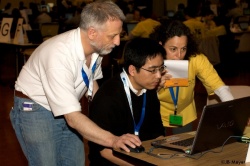Crossing frontiers
Report: John Brosky
In 2011 more than 30,000 hospital caregivers in 10 European countries will participate in an exchange of electronic patients’ records (EPRs) in the world's largest, first-ever cross-border connection of e-health systems. Brussels refers to this as a ‘large-scale e-health implementation’, and while it is easy to laugh about the bureaucratic language, it was the careful, go-slow approach of politicians, and not technology wizards, that brought about this landmark achievement.


In any language, the project -- called European Patient Smart Open Services (epSOS) -- can be said to be moving quickly across a landscape that is famously fragmented by diverse healthcare systems, and in a field that has stubbornly defied the best efforts to bring the benefits of IT to patient care.
The European Commission provided funding of €11 million and set a deadline of 36 months for the large-scale implementation. (See EH issue 5/08).
According to Fredrik Linden, the project’s coordinator, 350 people are now actively completing the tasks outlined in 10 different work packages that will prepare the ground for the test operations in 2011. ‘There are many significant issues to be solved to fulfil the Commission’s vision of e-health as an enabler for continuity of care both within the Member States and across borders between the Member States,’ he explained, when interviewed by European Hospital during the recent European Connectathon in Bordeaux, France, where he reported on epSOS progress. ‘The epSOS project picked only two small issues out of this context, yet they are proving to be a world-class challenge.’
It took the epSOS work groups a full year just to sort out the legal implications among Member States of transferring EPR data and then to arrive at a framework agreement that will create a ‘circle of trust,’ Fredrick Linden reported.
A related set of problems, which has been solved, was patient identification, a headache for IT developers, even when sending data from one hospital department to another, and the equally troublesome need to identify healthcare professionals who are authorized to open patient records.
The availability of EPRs in 12 different countries is uneven, he explained, and poses a two-sided puzzle because e-prescription data sets are separate from the databases recording the dispensation of medications.
The work groups burned up another 12 months defining the technical specification needed to connect national systems at different levels.
A critical principle of epSOS is not to alter any Member State’s current health information system, choosing instead to create a technical interface that will allow these different systems to work together, or interoperate -- which explains why he and members of epSOS work groups were in Bordeaux for the European Connectathon.
The critical next step in the epSOS development, he explained, will be a ‘Projectathon’ to test the technical interface for transferring patient medical summaries and medication data, which is planned for early 2011. Once the systems are verified during the connectivity marathon, the large-scale implementation will go forward.
The Projectathon will be run on the same model as the European Connectathon organized by the non-profit association Integrating the Healthcare Enterprise (IHE), but reserved exclusively to countries participating in the epSOS project and the vendors whose systems support the technical architecture.
‘When you are testing interoperability, it is rare that the problem is only on one side,’ said Claudio Saccavini, who is a veteran monitor of the IHE-Europe Connectathon and recently led a project connecting hospitals in the Venato region of Italy. ‘The big advantage for Connectathon is that everyone is working together in the same room and companies can work out the system problems and solve them quickly.’
IHE-Europe is formally part of the epSOS project team working with the 12 Member States under the Commission’s large-scale implementation model, and the association represents 35 industry partners.
The first phase of the real-time epSOS implementation in 2011 will be an exchange among the 10 participating countries that Fredrik Linden called ‘any-to-all’, to demonstrate the systems are connecting correctly. While there are 12 Member States formally participating in the epSOS project, he explained that five of the original Member States are not ready to participate in the test operation, while three other countries not part of the original epSOS group have asked to participate leaving the final participation at 10 countries for the patient data exchange in 2011.
In the second phase of the large-scale implementation, needing the involvement of thousands of healthcare workers, each country will act out a real-world script requiring detailed EPRs. For example, the medical requests from Sweden and Denmark are built around the Oresund Bridge that connects the two countries and carries 20,000 people daily, including tourists and visiting workers from other Member States who frequently turn up for medical care.
France will use Erasmus students for its scenario, either requesting or sending medical data to the student’s home country.
In his presentation at the European Connectathon, Fredrik Linden announced that 11 more European Member States have asked to join the epSOS project. In response, the Commission is now preparing a proposal for funding a 24-month extension of the epSOS project under its 7th Framework Programme, which will bring the new Member States onboard.
The success of the epSOS project has encouraged the Commission to go further with the participatory model to advance a vision of e-health not only as an enabler for patient care but also as a driver for technological innovation and job creation.Benoit Abeloos, the project officer for eHealth with the Commission's Directorate General for the Information Society& Media, told participants at the European Connectathon a ‘very large-scale implementation’ is currently being planned.
Targeting a horizon of 2014, the European Large Scale Action (ELSA) aims to raise the game for European e-health by covering the full landscape from research and development through to a full-scale deployment of technologies in a programme involving national health authorities, patient organisations, various European industries, academic institutions and clinical experts.
Further details: www.epsos.eu
21.05.2010




